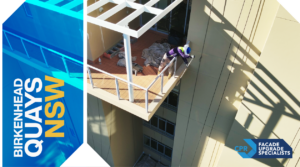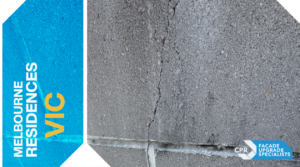Planning a realistic budget for facade remediation in NSW can be challenging, especially for strata committees managing ageing high-rise buildings or commercial owners dealing with compliance upgrades. Understanding remediation costs, compliance tips, and cost-saving technologies can help you plan smarter and avoid surprises.
Understanding Remediation Costs for NSW Buildings
When it comes to facade remediation in NSW, cost planning starts with understanding what drives your budget. Factors such as the extent of concrete spalling, cladding replacement, access system, and compliance requirements all play a role.
Traditional scaffolding methods can consume up to 30% of your total budget, but CPR’s Scaffold-Free™ technology—powered by MARS™, PEARS®, and SkyPod®—removes that burden entirely. This means your funds go directly into quality workmanship and long-term building care, rather than temporary structures.
By using SKY-FIMMS™, our digital facade management system, we quantify every defect before work begins—giving you a precise, data-backed cost projection and removing the guesswork from your remediation plan.
Strata Budgeting Tips for Long-Term Building Health
Strata committees often face the difficult task of balancing immediate repair needs with long-term financial planning. The key is to view facade remediation not as an expense but as a strategic investment in the building’s safety, aesthetics, and market value.
Here are some practical tips for smarter budgeting:
- Schedule periodic inspections through CPR’s SFS360® (Sky Facade Scope 360) to detect early signs of deterioration.
- Set aside a dedicated sinking fund for facade repairs, updated annually with inflation and material cost trends.
- Engage with CPR’s consultants early for accurate scope and cost forecasting, reducing the risk of special levies or emergency works.
With SE2EPC® (Sky End 2 End Project Care), CPR provides transparent project planning, photographic documentation, and quality assurance from start to finish—so your strata budget stays predictable and under control.
How CPR Helps Strata and Commercial Owners Save
CPR’s proprietary Scaffold-Free™ systems were designed to deliver high-quality remedial works with significant time and cost savings. Our MARS™ and PEARS® access systems allow technicians to reach any area of the facade safely and quietly, while SkyPod® provides a self-contained workstation that reduces disruption to residents and tenants.
This approach translates into:
- Up to 20% reduction in overall remediation costs.
- Shorter project timelines—works completed in months, not seasons.
- Minimal impact on daily operations or resident privacy.
In short, you gain cost efficiency without compromising on safety, quality, or compliance.
Compliance Tips for Developers and Strata Committees in NSW
Regulatory compliance plays a major role in facade budgeting, especially with evolving NSW building standards and combustible cladding reforms. Failing to meet compliance requirements can result in costly rework or penalties.
CPR’s consultancy and inspection team stays aligned with the latest NSW Building Commissioner guidelines, offering end-to-end support from condition reports to remediation certification.
Our specialists ensure your building meets:
- NSW Government cladding safety regulations
- Australian Standards for concrete and facade integrity
- WorkSafe NSW requirements for height safety and access
With CPR, compliance isn’t just a checkbox—it’s a transparent, traceable process documented through SKY-FIMMS™for full accountability.
Realistic Budget Planning: Parramatta and Beyond
From Parramatta to the broader Sydney region, remediation costs vary depending on building type, height, and material condition. CPR’s experience across commercial towers, heritage assets, and strata complexes allows us to provide realistic, location-specific cost assessments.
By combining on-site inspections with our digital modelling tools, we help strata committees and asset managers set accurate budgets before tenders are even issued. This proactive approach prevents cost blowouts and ensures funding is ready when remediation begins.
Future-Proofing Your Investment
Your building is a long-term asset, and budgeting should reflect that. After the remediation project, ongoing maintenance through CPR’s AfterCare™ program ensures your facade remains compliant, safe, and attractive for decades.
Regular condition checks, small-scale touch-ups, and digital record updates via SKY-FIMMS™ make it easier to track performance and forecast future maintenance costs.
With CPR, facade remediation isn’t a one-time project—it’s a complete Preserve, Protect, and Upgrade strategy that keeps your building strong, compliant, and valuable for years to come.
Smart Strata Budgeting and Remediation Cost Planning in Parramatta and Across NSW
Smart planning for Budgeting for Facade Remediation in NSW: Tips for Strata and Commercial Owners can safeguard your asset, satisfy compliance and protect residents & tenants.
Keeping a high‑rise or difficult‑access building in peak condition is never cheap, but with the right strategy you can turn façade remediation from an unpredictable cost‑centre into a planned investment. This long‑form guide walks strata committees and commercial property owners through the facade remediation budget Australia process—showing how to forecast a realistic building repair cost estimate, how NSW regulation shapes pricing, and where CPR’s patented Scaffold‑Free™ systems can save you time and money.
Why façade remediation matters for strata & commercial buildings
The hidden costs of delay
Ignoring concrete cancer, spalling or failed sealants may seem like a short‑term saving, yet every month of postponement escalates the scope of treatment. Data collected through our SFS360® close‑up inspections shows that a small $50 000 crack‑repair program can balloon to $400 000+ if water ingress is allowed to spread. Worse, legislative changes such as the Building Compliance Facade Repairs requirements in the NSW Design & Building Practitioners Act 2020 impose penalties if defects are not addressed.
Asset value & insurance implications
A well‑maintained exterior directly influences valuers, tenants and insurers. In the past five years we have observed strata schemes that undertook proactive facade remediation NSW works attracting premiums 12‑15 % lower than comparable buildings of similar age.
Understanding your façade remediation budget: key cost drivers
- Access methodology – Traditional scaffolding can represent 30–50 % of your total façade upgrade costs NSW. CPR’s Scaffold‑Free™ approach—combining MARS™ rope drops, PEARS® elevation and SkyPod® workstations—cuts that figure to as little as 10 %, delivering six‑figure savings on towers over 15 storeys.
- Extent of concrete or façade degradation – Quantity surveying undertaken with SFS360® gives strata committees an accurate patch‑count so they can begin strata capital works funding discussions early.
- Material specification – Choosing high‑performance coatings or cathodic protection increases upfront spend but slashes the life‑cycle cost of façade works in Sydney.
- Compliance & professional fees – Engineers, fire assessors and design practitioners must all be budgeted. Leaving them out now leads to costly redesigns later.
Building repair cost estimate essentials: breaking down the numbers

Below is a typical 20‑storey commercial curtain‑wall in the Sydney CBD. While every building differs, the ratios illustrate where your budget will go:
| Cost Item | Typical % of Budget (Scaffolding) | Typical % with Scaffold‑Free™ |
|---|---|---|
| Access & Site Establishment | 35 % | 12 % |
| Removal & Remediation | 30 % | 40 % |
| Materials | 15 % | 18 % |
| Professional & Certifier Fees | 8 % | 10 % |
| Contingency | 7 % | 10 % |
| QA/AfterCare™ | 5 % | 10 % |
Tip: When seeking a building repair cost estimate, always ask providers to separate access costs. This lets you compare apples with apples and quickly see the savings from modern rope‑based systems.
NSW compliance & risk considerations
- Design & Building Practitioners Act 2020 – Requires a registered engineer to sign off on façade work valued over $5 000. Budget for at least 2 – 5 % of project cost.
- Work Health & Safety Regulation 2017 – Specifies obligations for working at height. CPR’s patented Upseiling® technique ensures continuous two‑rope redundancy, reducing insurance premiums.
- Council heritage overlays – If your structure sits in a conservation zone you may need specific coatings and reporting. Factor application fees (~$2 500) and potential time delays.
Budgeting for façade repairs: creating a practical capital‑works plan
1. Commission a detailed façade inspection
Book a Building Facade Inspection with CPR. Our rope‑access technicians grid your elevations, photograph every defect and load data into the cloud—ideal evidence for owners‑corporation funding motions.
2. Align budget cycles with remediation phases
Split work into urgent, priority and enhancement packages so strata building repair planning aligns with annual levies.
3. Build contingency the smart way
Industry norm is 10 %. With Scaffold‑Free™ access, weather delays drop dramatically, so 7 % may be sufficient—but always keep a buffer for hidden substrates.
4. Engage stakeholders early
Commercial landlords should brief tenants on noise windows; strata committees should circulate SFS360® defect maps before the AGM to accelerate voting.
Strata façade maintenance & financial planning: how committees can stay ahead
- Implement a rolling 10‑year capital works fund that allocates 1–1.5 % of building replacement value to façade upkeep.
- Use AfterCare™ service contracts to spread costs as predictable quarterly fees, reducing levy spikes.
- Tap into strata loan products: several lenders in NSW offer amortised terms aligned to owners’ levy cycles.
Commercial building repairs NSW: aligning budgets with business goals
Hotel, retail and government assets demand minimal operational disruption. CPR’s encapsulated SkyPod® stations allow night shifts without obstructing entrances—significantly lowering lost‑trade costs that rarely appear in a conventional quote but drain the balance sheet.
Façade upgrade costs NSW: balancing quality, safety and spend
Cheapest is not best. A low‑cost applicator using inferior sealants may require rework within five years. When comparing proposals, calculate Whole‑Of‑Life Cost (WoLC):
WoLC = Initial Capital + Maintenance + Operating Disruption + Disposal – Residual Value
Projects delivered with CPR’s PEARS®/SkyPod® system typically show a 20‑30 % better WoLC over 25 years.
How to budget for facade remediation: step‑by‑step process
- Define scope via SFS360® inspection
- Request itemised access & trade pricing
- Assess compliance & consultant fees
- Run a risk workshop to set contingency
- Sequence works to match cashflow
- Secure finance / levy approvals
- Lock in program with SE2EPC® project plan
Strata building repair planning tools: SFS360® & ASP’s™
SFS360® generates high‑resolution repair heat‑maps, while ASP’s™ database gives you pre‑qualified trades and real‑time budget tracking—perfect for transparent owners‑corporation reporting.
Cost of façade works in Sydney: benchmarking real‑world projects
| Building Type | Height | Access Method | Cost/ m² |
| 1980s Strata Tower, CBD | 24 storeys | Scaffold‑Free™ | $185–$260 |
| 1990s Commercial Curtain Wall, Parramatta | 18 storeys | BMU + Rope | $90–$140 |
| 1970s Heritage Brick, Inner West | 8 storeys | Scaffold | $210–$320 |
Costs include concrete repair, re‑coating and QA photography but exclude GST.
Building compliance facade repairs: avoiding penalties and insurance pitfalls
Failing to address known defects can void public‑liability cover. Insurers increasingly ask for evidence of remedial scope within 60 days of a defect report—another reason to budget early.
Façade maintenance tips for strata committees
- Schedule annual rope‑access wash‑downs to remove pollutants that accelerate corrosion.
- Log all repairs in the SE2EPC® cloud for future budget planning.
- Use energy‑efficient coating systems to cut HVAC loads by up to 8 %.
NSW building defect repairs funding options
| Option | Key Points |
| Strata Capital Works Funding | Minor special levies spread over 3–5 years. Requires majority vote. |
| Strata Loans | Fast approval; repayments added to quarterly levies. Interest is tax‑deductible for investors. |
| Government Heritage Grants | Up to $100 000 for qualifying façades. Competitive. |
Remedial works planning NSW: choosing a Scaffold‑Free™ partner
Questions to ask bidders:
- Do you own proprietary access systems like PEARS®/SkyPod® or will you sub‑hire scaffold?
- How will you photograph and log each repair for QA?
- Can you show case studies where commercial façade maintenance budgeting achieved lifecycle savings?
- Does your AfterCare™ contract include free annual inspections?
Commercial façade maintenance budgeting: AfterCare™ & lifecycle savings
AfterCare™ converts unpredictable patch repairs into a fixed‑fee model covering inspections, minor rectifications and compliance certificates—ideal for CFOs seeking clarity.
Planning façade remediation project NSW: timeline & cash‑flow strategy
- Month 0–2: Inspection & budget approval.
- Month 3–4: Design & authority approvals.
- Month 5–10: Remediation works over staged drops.
- Month 11: Practical completion & QA sign‑off.
- Month 12+: AfterCare™ commences.
Staggering works drop‑by‑drop lets you pay only for completed sections—aligning invoices with levies or rental cycles.
Ready to protect your asset? Book a facade remedial consultation today
Don’t let small cracks become large costs. Book a Facade Remedial Consultancy or schedule a Building Facade Inspection with CPR Facade Upgrade Specialists. Already have a scope? Explore our Facade Remediation & Preservationservices to see how Scaffold‑Free™ technology can slash your budget.






